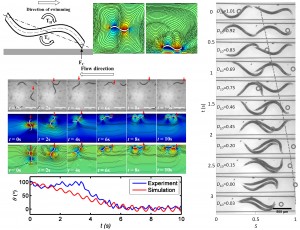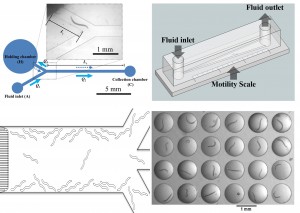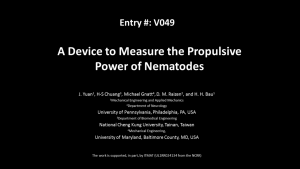Keywords: C. elegans, electrotaxis, microfluidics, dielectrophoresis, synchronization, propoulsive power, exercise, drop, high throughput, sorting, motility, rheotaxis, bordertaxis, surface, hydrodynamics
Publications
- Chuang, H.-S., Raizen, D. M., Lamb, A., Dabbish, N. & Bau, H. H. Dielectrophoresis of Caenorhabditis elegans. Lab Chip 11, 599-604 (2011).
- Chuang, H.-S., Raizen, D. M., Dabbish, N. & Bau, H. H. Electro-worming: The Behaviors of Caenorhabditis (C.) elegans in DC and AC Electric Fields. Phys. Fluids 23, 091107 (2011).
- Belfer, S. J., Chuang, H. S., Freedman, B. L., Yuan, J., Norton, M., Bau, H. H. & Raizen, D. M. Caenorhabditis-in-drop array for monitoring C. elegans quiescent behavior. Sleep 36, 689-698 (2013).
- Yuan, J., Raizen, D. M. & Bau, H. H. Gait synchronization in Caenorhabditis elegans. Proc. Natl Acad. Sci. USA 111, 6865-6870 (2014).
- Yuan, J., Raizen, D. M. & Bau, H. H. Propensity of undulatory swimmers, such as worms, to go against the flow. Proc. Natl Acad. Sci. USA 112, 3606-3611 (2015). Highlighted by Nature Physics 11, 297 (2015).
- Yuan, J., Zhou, J., Raizen, D. M. & Bau, H. H. High-throughput, motility-based sorter for microswimmers such as C. elegans. Lab Chip, Advance Article (2015). DOI: 10.1039/C5LC00305A
- Yuan, J., Raizen, D. M. & Bau, H. H. A hydrodynamic mechanism for attraction of undulatory microswimmers to surfaces. J. R. Soc. Interface, Accepted (2015).
Online Videos
Why are Undulatory Swimmers Attracted to Surfaces (Bordertaxis)?
Why Undulatory Swimmers Go Against the Flow (Rheotaxis)?
Do Proximate Micro-Swimmers Synchronize their Gait?
A Device to Measure the Propulsive Power of Nematodes
Videos
- http://arxiv.org/abs/1010.3188 Han-Sheng Chuang, David Raizen, Nooreen Dabbish, and Haim Bau, Electro-worming: The Behaviors of Caenorhabditis (C.) elegans in DC and AC Electric Fields, best video award, 63rd APS/DFD meeting, Long Beach, CA, 11/20-11/23, 2010
- http://arxiv.org/abs/1110.3691, J. Yuan, H-S Chunag, M. Gnatt, D. M., Raizen, and H. H. Bau, 2011, A Device to Measure the Propulsive Power of Nematodes, 64th APS/DFD meeting, Baltimore, MD, 11/20-11/22.
- http://arxiv.org/abs/1210.4071, Jinzhou Yuan, Kun He Lee, David M. Raizen, and Haim H. Bau, 2012, Do Proximate Micro-Swimmers Synchronize their Gait?, 65th APS/DFD meeting, San Diago, CA, 11/18-11/20.
- Yuan, J. Raizen, D. M. & Bau, H. H. Why are undulatory swimmers attracted to surfaces (Bordertaxis)? Gallery of fluid motion (V0077), American Physical Society, 67th Meeting of the Division of Fluid Dynamics, San Francisco, CA, Nov. 2014.
- Yuan, J. Raizen, D. M. & Bau, H. H. Why undulatory swimmers go against the flow (Rheotaxis)? Gallery of fluid motion (V0078), American Physical Society, 67th Meeting of the Division of Fluid Dynamics, San Francisco, CA, Nov. 2014.
Collaborators:
Professor David Raizen



